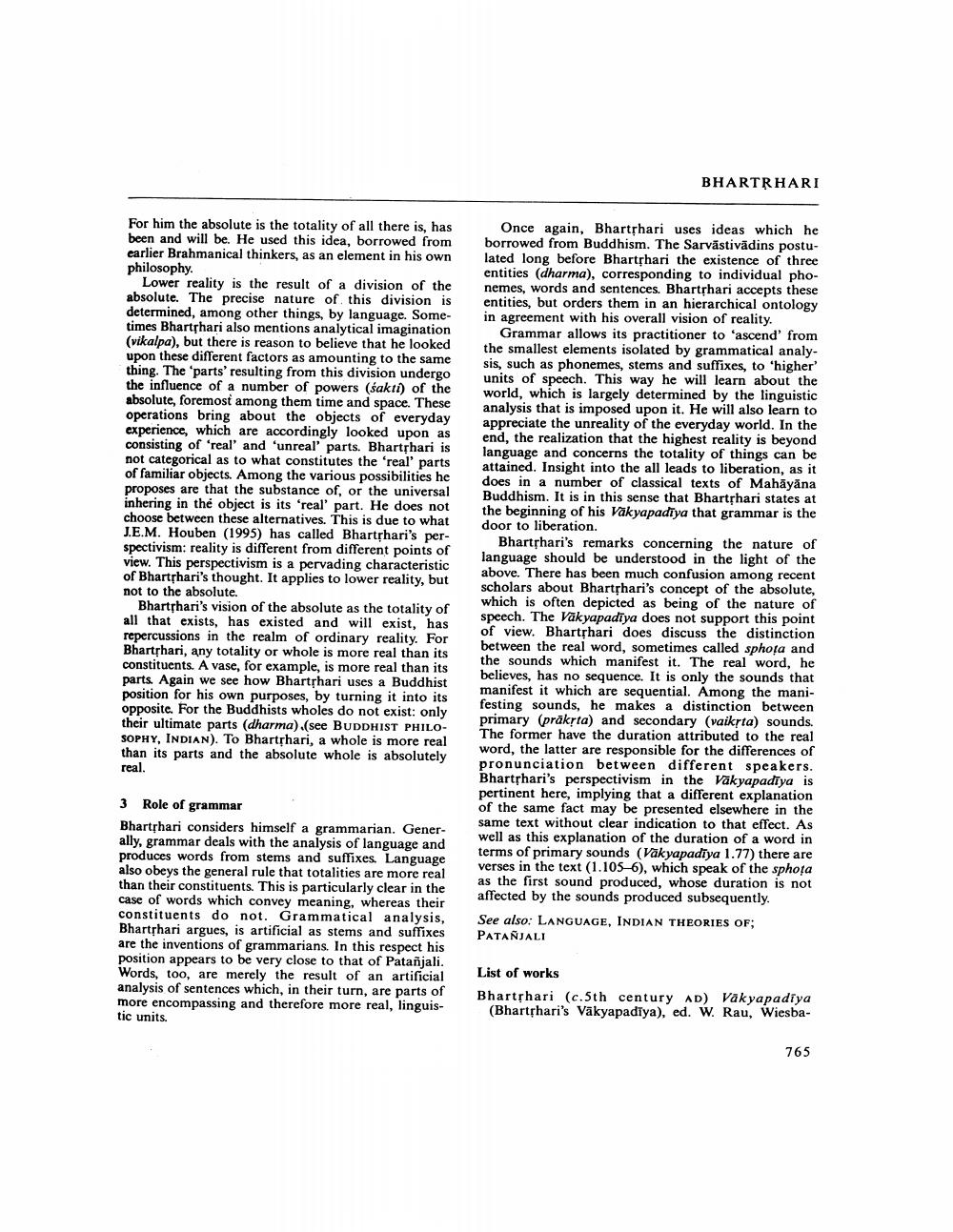Book Title: Reviews Of Diffeent Books Author(s): Johannes Bronkhorst Publisher: Johannes Bronkhorst View full book textPage 2
________________ For him the absolute is the totality of all there is, has been and will be. He used this idea, borrowed from earlier Brahmanical thinkers, as an element in his own philosophy. Lower reality is the result of a division of the absolute. The precise nature of this division is determined, among other things, by language. Sometimes Bhartṛhari also mentions analytical imagination (vikalpa), but there is reason to believe that he looked upon these different factors as amounting to the same thing. The 'parts' resulting from this division undergo the influence of a number of powers (śakti) of the absolute, foremost among them time and space. These operations bring about the objects of everyday experience, which are accordingly looked upon as consisting of 'real' and 'unreal' parts. Bhartṛhari is not categorical as to what constitutes the 'real' parts of familiar objects. Among the various possibilities he proposes are that the substance of, or the universal inhering in the object is its 'real' part. He does not choose between these alternatives. This is due to what J.E.M. Houben (1995) has called Bhartṛhari's perspectivism: reality is different from different points of view. This perspectivism is a pervading characteristic of Bhartṛhari's thought. It applies to lower reality, but not to the absolute. Bharthari's vision of the absolute as the totality of all that exists, has existed and will exist, has repercussions in the realm of ordinary reality. For Bhartṛhari, any totality or whole is more real than its constituents. A vase, for example, is more real than its parts. Again we see how Bhartṛhari uses a Buddhist position for his own purposes, by turning it into its opposite. For the Buddhists wholes do not exist: only their ultimate parts (dharma).(see BUDDHIST PHILOSOPHY, INDIAN). To Bhartṛhari, a whole is more real than its parts and the absolute whole is absolutely real. 3 Role of grammar Bhartṛhari considers himself a grammarian. Generally, grammar deals with the analysis of language and produces words from stems and suffixes. Language also obeys the general rule that totalities are more real than their constituents. This is particularly clear in the case of words which convey meaning, whereas their constituents do not. Grammatical analysis, Bhartṛhari argues, is artificial as stems and suffixes are the inventions of grammarians. In this respect his position appears to be very close to that of Patanjali. Words, too, are merely the result of an artificial analysis of sentences which, in their turn, are parts of more encompassing and therefore more real, linguistic units. BHARTRHARI Once again, Bhartṛhari uses ideas which he borrowed from Buddhism. The Sarvästivädins postulated long before Bhartṛhari the existence of three entities (dharma), corresponding to individual phonemes, words and sentences. Bhartṛhari accepts these entities, but orders them in an hierarchical ontology in agreement with his overall vision of reality. Grammar allows its practitioner to 'ascend' from the smallest elements isolated by grammatical analysis, such as phonemes, stems and suffixes, to 'higher' units of speech. This way he will learn about the world, which is largely determined by the linguistic analysis that is imposed upon it. He will also learn to appreciate the unreality of the everyday world. In the end, the realization that the highest reality is beyond language and concerns the totality of things can be attained. Insight into the all leads to liberation, as it does in a number of classical texts of Mahāyāna Buddhism. It is in this sense that Bhartṛhari states at the beginning of his Vakyapadiya that grammar is the door to liberation. Bhartṛhari's remarks concerning the nature of language should be understood in the light of the above. There has been much confusion among recent scholars about Bhartṛhari's concept of the absolute, which is often depicted as being of the nature of speech. The Vakyapadiya does not support this point of view. Bhartṛhari does discuss the distinction between the real word, sometimes called sphota and the sounds which manifest it. The real word, he believes, has no sequence. It is only the sounds that Imanifest it which are sequential. Among the manifesting sounds, he makes a distinction between primary (präkṛta) and secondary (vaikṛta) sounds. The former have the duration attributed to the real word, the latter are responsible for the differences of pronunciation between different speakers. Bhartṛhari's perspectivism in the Väkyapadiya is pertinent here, implying that a different explanation of the same fact may be presented elsewhere in the same text without clear indication to that effect. As well as this explanation of the duration of a word in terms of primary sounds (Vakyapadiya 1.77) there are verses in the text (1.105-6), which speak of the sphota as the first sound produced, whose duration is not affected by the sounds produced subsequently. See also: LANGUAGE, INDIAN THEORIES OF; PATANJALI List of works Bhartṛhari (c.5th century AD) Vakyapadiya (Bhartṛhari's Vakyapadīya), ed. W. Rau, Wiesba 765Page Navigation
1 2 3
